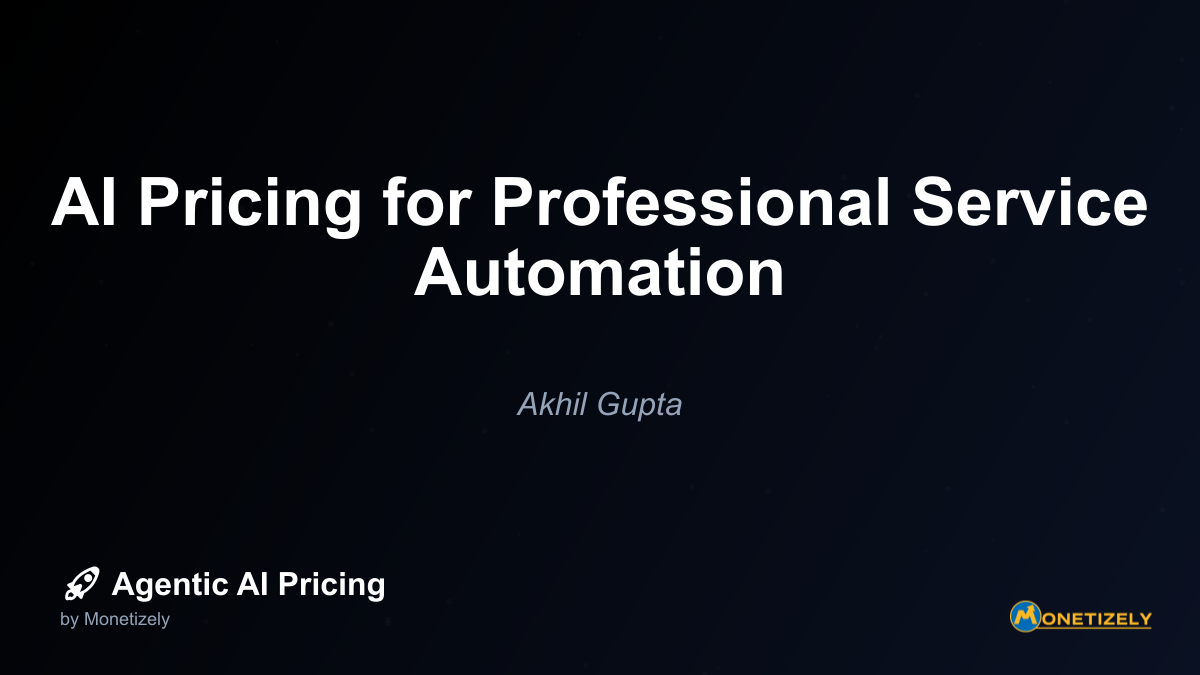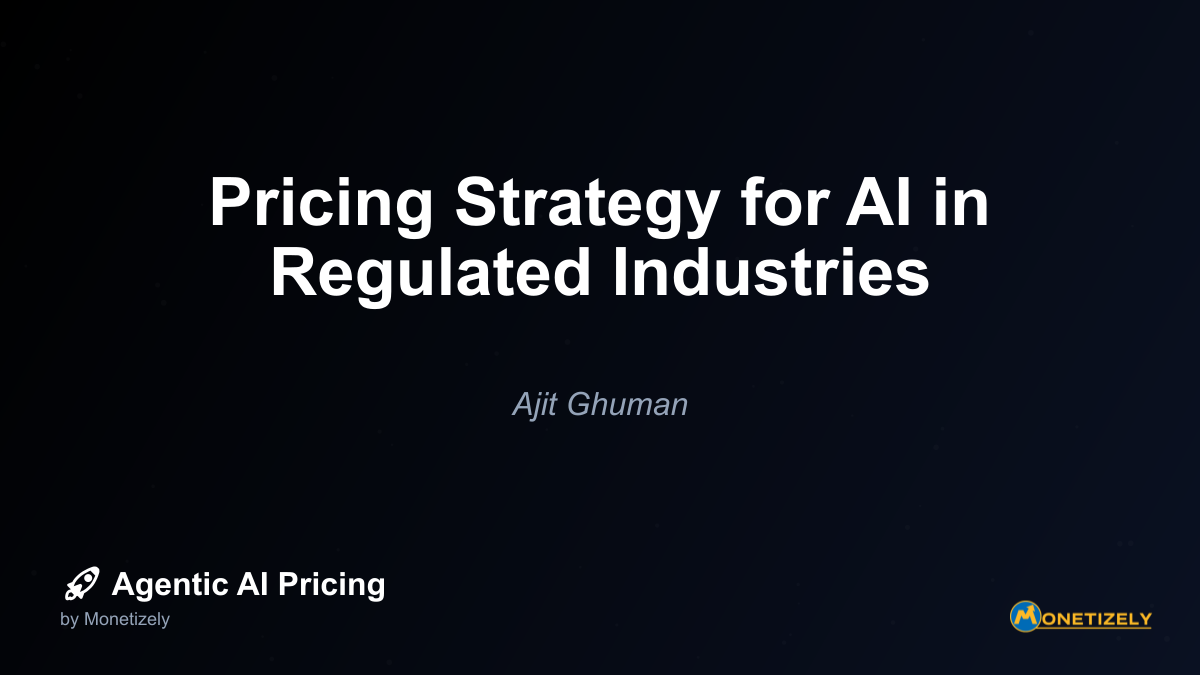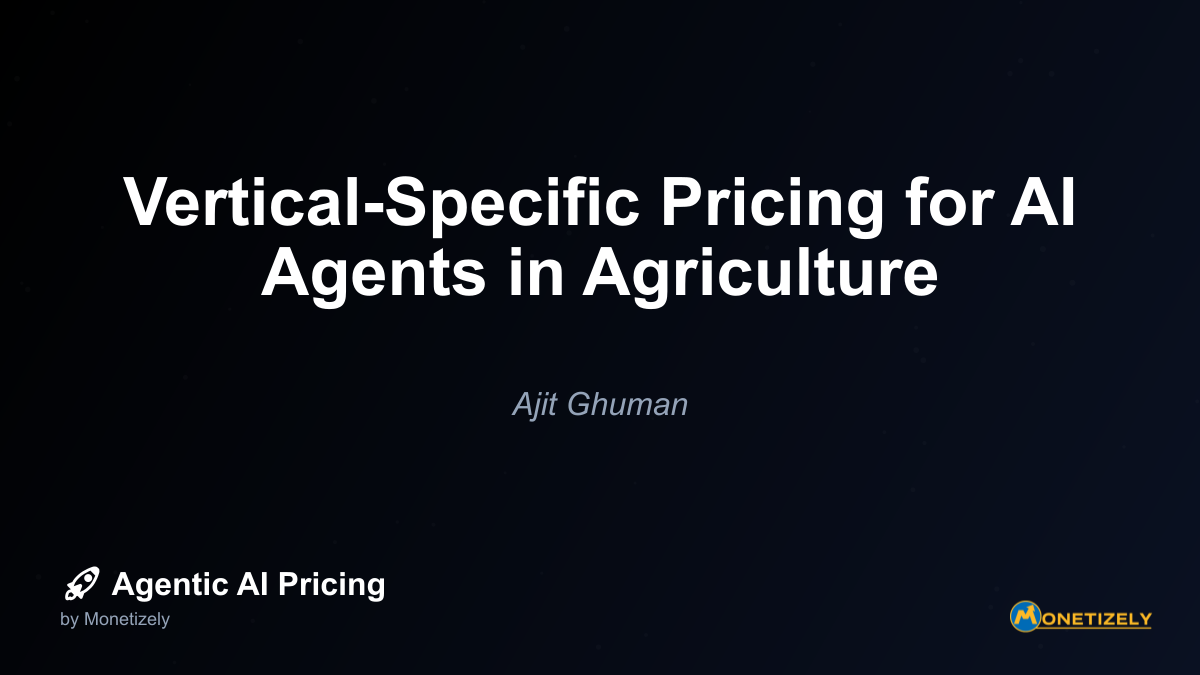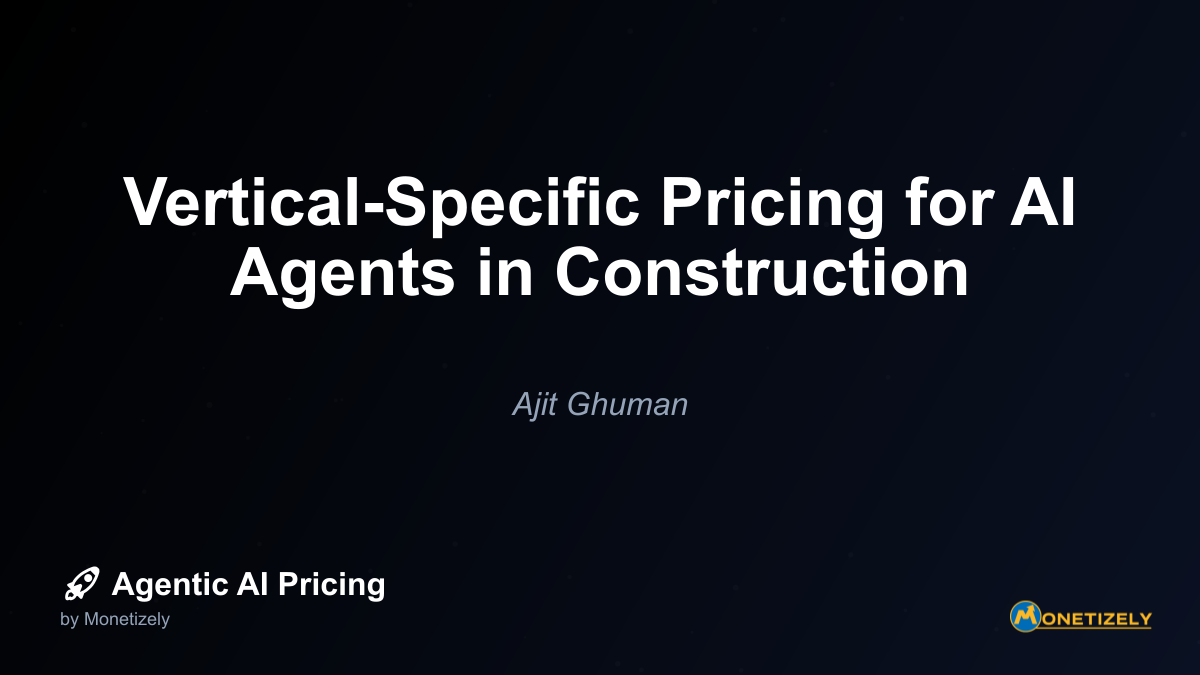· Ajit Ghuman · Industry-Specific · 11 min read
Vertical-Specific Pricing for AI Agents in Human Resources
AI and SaaS Pricing Masterclass
Learn the art of strategic pricing directly from industry experts. Our comprehensive course provides frameworks and methodologies for optimizing your pricing strategy in the evolving AI landscape. Earn a professional certification that can be imported directly to your LinkedIn profile.
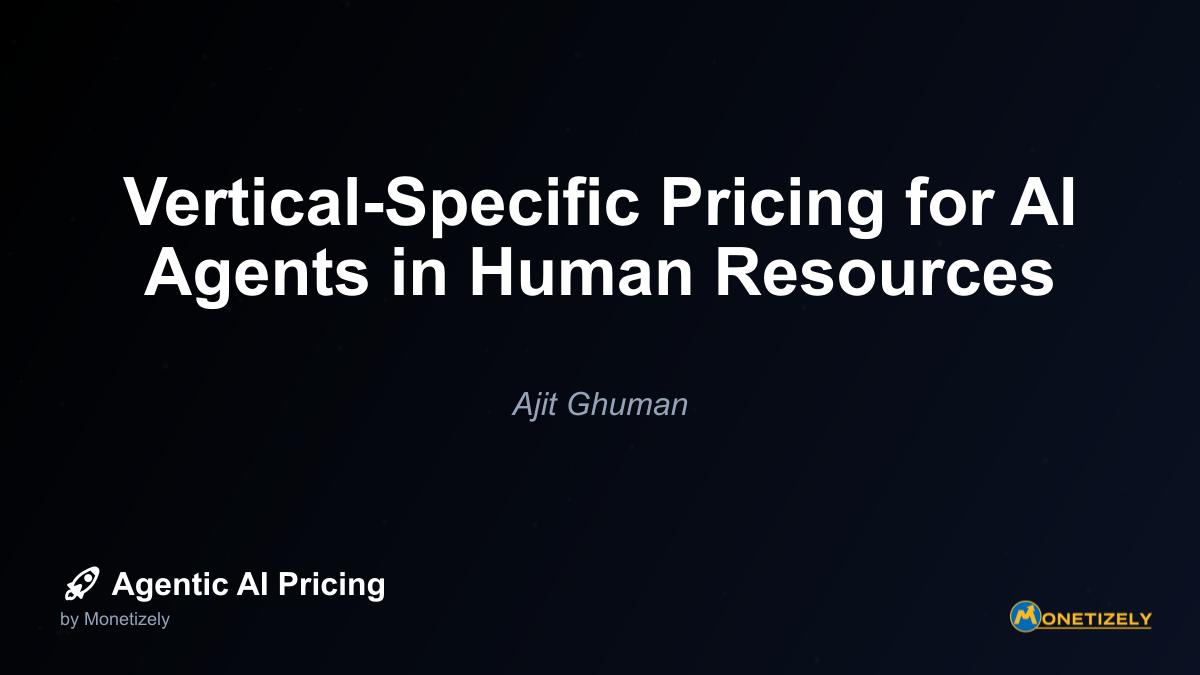
The HR landscape is undergoing a profound transformation as artificial intelligence redefines core functions from recruitment to retention. This evolution has sparked diverse pricing approaches tailored to the unique challenges and opportunities within human resources. Organizations navigating this complex ecosystem must understand the nuanced pricing models emerging across HR’s AI-powered applications to maximize value while managing costs effectively.
The Evolution of HR AI Pricing Models
Traditional HR software pricing has historically relied on per-seat licensing, with organizations paying based on employee headcount. However, the integration of AI capabilities has fundamentally disrupted this paradigm. According to recent data from 2025, seat-based pricing for AI solutions has declined significantly, dropping from 21% to just 15% of AI companies within a single year.
This shift reflects the unique value proposition AI brings to HR functions—where automation at scale delivers exponential rather than linear benefits. As HR leaders increasingly recognize this disconnect between traditional pricing and AI’s value delivery, several alternative models have emerged:
Usage-Based Resource Consumption
Under this model, organizations pay based on actual cloud resources consumed by AI workloads. This approach is particularly common for computationally intensive processes like:
- Resume parsing and candidate screening
- Video interview analysis
- Employee sentiment processing
- Predictive analytics for workforce planning
While usage-based pricing aligns costs with actual consumption, it introduces challenges around predictability. HR departments often struggle to forecast fluctuating model costs, making budget planning difficult.
Token or Credit Systems
Token-based pricing has gained significant traction for HR AI applications involving discrete interactions or outputs. Organizations purchase token bundles upfront, which are then consumed as tasks complete:
- Candidate outreach emails
- Personalized feedback generation
- Interview question customization
- Job description optimization
The token approach offers granular consumption tracking and cost control, allowing HR teams to allocate resources to priority areas while maintaining budget discipline.
Output-Based Pricing
Some HR AI vendors have adopted output-based pricing models where costs directly correlate with quantifiable AI outputs:
- Number of qualified candidates identified
- Completed interview screenings
- Generated performance reviews
- Retention risk assessments
This approach creates strong ROI alignment and transparency, as organizations pay only for measurable results.
Agent-Based Subscription Models
Perhaps the most transformative pricing approach involves AI agents dedicated to specific HR roles. Under this model, customers pay subscription fees representing the digital labor substitution cost for functions like:
- Recruiting coordinator agents
- Onboarding specialists
- Benefits administration assistants
- Compensation analysts
According to Boston Consulting Group’s 2025 analysis, agent-based pricing often involves high fixed fees justified by the comprehensive role replacement these sophisticated AI systems provide.
Vertical-Specific Pricing Across HR Functions
The human resources vertical encompasses diverse functions, each with unique AI application patterns and corresponding pricing considerations. Understanding these nuances is essential for organizations evaluating HR AI investments.
Recruitment and Talent Acquisition
Recruitment represents one of the most AI-mature segments within HR, with sophisticated solutions addressing everything from candidate sourcing to interview scheduling.
Dominant Pricing Models in Recruitment AI
Performance-Based Pricing: Many recruitment AI vendors tie costs directly to successful placements or qualified candidate delivery. This model, resembling traditional recruitment agency structures, typically involves:
- Base platform fees
- Success fees per qualified candidate
- Tiered pricing based on position seniority
Volume-Based Pricing: For high-volume hiring scenarios, vendors offer pricing based on requisition numbers or candidate throughput:
- Per-job posting fees with AI enhancement
- Candidate screening packages (e.g., 500/month)
- Unlimited screening within hiring volume tiers
Hybrid Value-Capture Models: Sophisticated recruitment AI platforms increasingly combine elements of both approaches:
- Core platform subscription
- Usage fees for advanced AI features
- Performance incentives aligned with quality-of-hire metrics
Case Study: Unilever’s Recruitment AI Implementation
Unilever provides an instructive example of AI recruitment value. Their implementation of AI-driven video interviewing and game-based assessments delivered remarkable results:
- 90% reduction in resume review time
- 75% decrease in time-to-hire
- 16% increase in candidate diversity
While exact pricing details remain confidential, the scale of efficiency gains demonstrates why organizations increasingly accept premium pricing for recruitment AI that delivers measurable outcomes.
Employee Engagement and Experience
AI-powered engagement solutions represent a growing segment with distinctive pricing approaches reflecting their continuous, relationship-oriented nature.
Pricing Models in Engagement AI
Pulse-Based Pricing: Some vendors charge based on survey frequency and depth:
- Monthly engagement pulse surveys
- Quarterly comprehensive assessments
- Real-time sentiment monitoring
Intervention-Based Models: More sophisticated platforms price according to AI-generated interventions:
- Personalized coaching recommendations
- Manager action prompts
- Recognition suggestions
Outcome-Aligned Pricing: Advanced vendors increasingly link pricing to engagement improvements:
- Baseline establishment fees
- Subscription during improvement period
- Success fees for sustained engagement gains
The engagement AI market shows particular sensitivity to ethical considerations, with premium pricing often justified by responsible AI features that ensure bias mitigation and privacy protection.
Workforce Analytics and Planning
Analytics represents perhaps the most mature AI application within HR, with sophisticated predictive capabilities commanding premium pricing.
Analytics AI Pricing Approaches
Tiered Insight Access: Many vendors structure pricing around analytical depth:
- Descriptive analytics (basic tier)
- Predictive capabilities (mid-tier)
- Prescriptive recommendations (premium tier)
Data Source Integration Pricing: Costs often scale with data complexity:
- Core HRIS data analysis (standard)
- Multi-system integration (advanced)
- External data incorporation (premium)
Use Case Licensing: Some vendors price according to specific analytical applications:
- Attrition prediction module
- Workforce planning toolkit
- Skills gap analysis package
According to 2025 industry data, workforce analytics AI shows the strongest ROI metrics among HR AI applications, with documented improvements in operational efficiency reaching up to 40%. This demonstrable value supports premium pricing models in this segment.
Enterprise vs. SMB Pricing Divergence
The HR AI market exhibits significant pricing stratification based on organizational size, with distinct models emerging for enterprise and SMB customers.
Enterprise HR AI Pricing
Large organizations typically encounter highly customized pricing reflecting their complex requirements:
Custom Implementation Fees: Enterprise deployments often involve substantial upfront costs covering:
- System integration with existing HR tech stacks
- Data migration and cleansing
- Workflow customization and automation
Enterprise License Agreements: Rather than per-seat pricing, many vendors offer enterprise-wide access with:
- Unlimited user licensing
- Comprehensive module access
- Multi-year agreements with built-in escalation
Success-Based Components: Sophisticated enterprises increasingly negotiate outcome-based elements:
- Retention improvement incentives
- Hiring efficiency targets
- Diversity and inclusion metrics
IBM’s implementation of AI-based compensation planning illustrates the enterprise approach. Their system supports thousands of managers with transparent, bias-mitigating tools integrated across multiple data sources—representing a high-investment, customized AI deployment with pricing reflecting both technical complexity and organizational scale.
SMB HR AI Pricing
Smaller organizations face different pricing structures designed for accessibility and scalability:
Simplified Tiered Pricing: Many SMB-focused vendors offer straightforward tiers:
- Starter packages (limited features, user counts)
- Professional tiers (expanded capabilities)
- Premium offerings (comprehensive functionality)
Per-Employee-Per-Month (PEPM) Models: This approach provides predictability:
- Linear scaling with headcount
- All-inclusive feature access
- Minimal upfront investment
Modular Add-Ons: Rather than enterprise-wide deployments, SMBs often adopt targeted solutions:
- Recruitment-specific AI tools
- Lightweight engagement platforms
- Essential analytics capabilities
According to recent market data, SMB-focused HR AI vendors like Lattice offer AI-enhanced performance management starting at approximately $11 per seat per month, while others like Betterworks employ custom pricing scaled to company size and functionality requirements.
Emerging Value-Based Pricing Paradigms
Beyond traditional approaches, innovative value-based pricing models are gaining traction in the HR AI market, particularly for high-impact applications.
ROI-Share Models
Some vendors now offer pricing tied directly to measurable business outcomes:
Retention Improvement Sharing: Vendors receive compensation based on reduced turnover costs:
- Baseline establishment period
- Agreed valuation of retention improvements
- Shared savings arrangements (typically 20-40%)
Hiring Efficiency Partnerships: For recruitment AI, pricing increasingly reflects tangible efficiency gains:
- Documented time-to-hire reductions
- Cost-per-hire improvements
- Quality-of-hire enhancements
Productivity Gain Participation: Advanced engagement and performance AI may price based on productivity impacts:
- Performance baseline measurement
- Ongoing productivity monitoring
- Fee structures capturing a percentage of gains
These models align vendor and customer incentives while providing compelling ROI justification for premium AI solutions.
Digital Labor Substitution Pricing
Perhaps the most intriguing pricing evolution involves AI agents that directly replace human labor in specific HR functions. These models price according to the labor value delivered rather than traditional software metrics:
Fractional FTE Replacement: Pricing reflects the percentage of a full-time role automated:
- 25% of recruiter compensation for sourcing automation
- 40% of HR administrator salary for documentation processing
- 30% of benefits specialist costs for inquiry handling
Task Completion Pricing: Some vendors charge based on discrete HR tasks completed:
- Per-candidate screening
- Per-employee onboarding
- Per-inquiry resolution
Outcome Guarantees: The most sophisticated models include performance guarantees:
- Service level agreements for task completion
- Quality assurance metrics
- Escalation protocols for complex scenarios
According to Boston Consulting Group research, these digital labor substitution models are particularly compelling for organizations seeking budget reallocation from human to AI resources while maintaining or improving service levels.
Implementation Costs Beyond Licensing
A comprehensive understanding of HR AI pricing must account for significant implementation costs beyond basic licensing fees:
Infrastructure Requirements
Organizations must consider the technical foundation needed to support AI deployments:
Cloud Resources: Many HR AI solutions require substantial computing power:
- Storage for historical HR data
- Processing capacity for model training
- Bandwidth for real-time interactions
Integration Architecture: Connecting AI with existing HR systems demands investment:
- API development and maintenance
- Data pipeline creation
- Authentication and security frameworks
Monitoring Infrastructure: Ongoing performance tracking requires dedicated resources:
- Usage dashboards
- Performance metrics
- Compliance monitoring
According to recent industry analysis, infrastructure costs represent a primary growth constraint for AI startups, with implications for both vendors and customers in the HR AI ecosystem.
Data Preparation and Governance
Perhaps the most overlooked cost category involves data readiness:
Historical Data Cleansing: Many organizations must invest heavily in preparing historical HR data:
- Standardizing formats across legacy systems
- Addressing missing or inconsistent information
- Anonymizing sensitive data for training purposes
Ongoing Data Governance: Maintaining data quality requires continuous investment:
- Data validation workflows
- Quality assurance protocols
- Compliance verification
Ethical AI Safeguards: Responsible AI deployment demands additional governance:
- Bias detection and mitigation
- Fairness auditing
- Transparency mechanisms
These data-related costs can easily exceed initial licensing fees, particularly for organizations with complex legacy HR systems or data quality challenges.
Change Management and Training
The human side of implementation represents another significant cost center:
Stakeholder Education: Organizations must invest in building AI literacy:
- Executive leadership education
- HR team capability building
- Manager training programs
Process Redesign: Existing workflows often require substantial modification:
- Documentation of current processes
- Future-state design
- Transition planning
Adoption Support: Ensuring user acceptance demands ongoing investment:
- Internal marketing campaigns
- Success story documentation
- Continuous improvement feedback loops
According to implementation experts, change management costs typically represent 15-30% of total HR AI investment, yet are frequently underbudgeted during initial planning.
ROI Calculation Frameworks for HR AI
Given the significant investment required, organizations need robust frameworks for calculating HR AI return on investment:
Efficiency Gain Quantification
The most straightforward ROI approach focuses on time and resource savings:
Time Reduction Metrics:
- Hours saved in recruitment screening
- Reduced administrative processing time
- Accelerated decision-making cycles
Resource Reallocation Opportunities:
- Headcount avoidance in transactional roles
- Shift from administrative to strategic activities
- Reduced reliance on external consultants
Process Acceleration Benefits:
- Faster time-to-hire impact on business outcomes
- Reduced onboarding time to productivity
- Quicker response to changing workforce needs
Organizations can calculate direct ROI by comparing these efficiency gains against total implementation and licensing costs.
Strategic Value Assessment
Beyond efficiency, sophisticated ROI frameworks incorporate strategic value creation:
Quality Improvement Metrics:
- Enhanced candidate quality measurements
- Improved employee engagement scores
- Better alignment of skills with requirements
Risk Mitigation Valuation:
- Reduced compliance violations
- Lower litigation exposure
- Enhanced data security
Competitive Advantage Quantification:
- Talent attraction improvements
- Workforce agility enhancements
- Innovation capacity increases
While more challenging to quantify, these strategic benefits often represent the most compelling long-term ROI justification for HR AI investments.
Comprehensive ROI Modeling
Leading organizations combine both approaches in phased ROI models:
Short-Term Efficiency Return (0-12 months):
- Immediate process automation benefits
- Administrative time savings
- Quick-win productivity enhancements
Mid-Term Quality Improvements (12-24 months):
- Hiring quality enhancements
- Engagement and retention gains
- Performance management optimization
Long-Term Strategic Advantages (24+ months):
- Workforce planning sophistication
- Organizational capability building
- Cultural transformation impacts
This phased approach provides realistic expectations while capturing both immediate and long-term value creation.
Case Studies: Real-World HR AI Pricing and ROI
Examining actual implementations provides valuable insights into HR AI pricing models and return on investment.
Unilever: AI-Driven Recruitment Transformation
Unilever’s implementation of AI-powered recruitment illustrates both the investment and returns possible from sophisticated HR AI:
Implementation Approach
Unilever deployed AI-driven video interviewing and game-based assessments across their global recruitment operations, focusing on early career positions.
Results Achieved
- 90% reduction in resume review time
- 75% decrease in time-to-hire
- 16% increase in candidate diversity
- Significant improvement in candidate experience
Pricing Implications
While specific pricing details remain confidential, the scale of efficiency gains demonstrates why organizations increasingly accept premium pricing for recruitment AI that delivers measurable outcomes. The case suggests a correlation between implementation scope, pricing investment, and ROI potential.
IBM: AI-Powered Compensation Management
IBM’s deployment of AI-based compensation planning tools offers insights into enterprise-scale HR AI implementation:
Implementation Approach
IBM integrated AI compensation tools with existing systems and external datasets to support thousands of managers with transparent, bias-mitigating decision support.
Key Features
- Transparency in compensation recommendations
- Managerial override capabilities
- Integration with performance data
- Bias detection and mitigation
Pricing and ROI Considerations
This implementation suggests high-investment, customized AI deployment with pricing reflecting both technical complexity and organizational scale. The ROI case focused on improved pay equity, reduced litigation risk, and enhanced employee satisfaction rather than pure efficiency metrics.
Amazon: Retention Analytics Implementation
Amazon’s application of AI for exit interview analysis demonstrates the retention-focused value proposition:
Implementation Approach
Amazon deployed AI tools to analyze exit interview data, identifying patterns and predictive indicators of employee departure risk.
Results Achieved
- 20% reduction in voluntary turnover
- Enhanced understanding of departure drivers
- Targeted intervention capability
- Improved retention of high performers
ROI Framework
The substantial turnover reduction translates directly to reduced hiring and training costs, providing clear financial justification for the AI investment despite premium pricing. For organizations with high replacement costs, retention-focused AI often presents the most compelling ROI case.
Ethical Considerations in HR AI Pricing
As HR AI handles increasingly sensitive decisions, ethical considerations have become central to both implementation and pricing strategies.
The Pricing Premium for Responsible AI
Vendors incorporating robust ethical AI frameworks often command pricing premiums reflecting additional development and governance costs:
- Bias Mitigation Tools: Features ensuring fair treatment across demographic groups
- Explainability Modules: Capabilities providing transparency into AI decision-making
- Compliance Certifications: Documented adherence to ethical AI standards
- Continuous Audit Capabilities: Ongoing monitoring for emerging ethical concerns
According to recent industry analysis, organizations increasingly view these features as non-negotiable requirements rather than premium add-ons, despite their impact on pricing.
Regulatory Compliance Cost Factors
Evolving regulations around AI in employment decisions directly
Co-Founder & CEO
Ajit is the author of Price To Scale, a top book on SaaS Pricing and is the Founder of Monetizely. Ajit has led and worked in pricing and product marketing at firms like Twilio, Narvar and Medallia. His work has been featured in Forbes and VentureBeat. Ajit regularly consults with software companies from Seed stage to post-IPO on pricing strategy. Ajit is also a highly-rated co-instructor for 'The Art of SaaS Pricing and Monetization' on Maven.
Pricing Strategy Audit
Let our experts analyze your current pricing strategy and identify opportunities for improvement. Our data-driven assessment will help you unlock untapped revenue potential and optimize your AI pricing approach.

